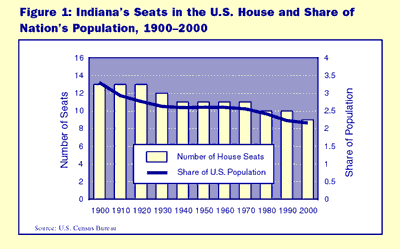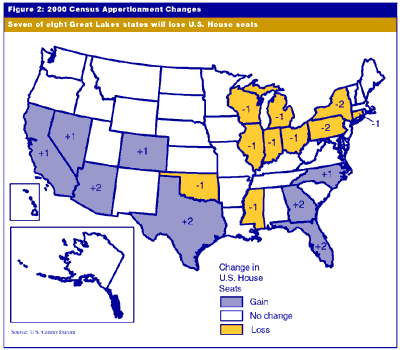Indiana Population Exceeds 6 Million, but U.S. House Seat Is Lost
On Dec. 28, 2000, the U.S. Census Bureau released the first population numbers from Census 2000. The Bureau announced that the nation's April 1, 2000, resident population stood at 281.4 million, an increase of 13.2%, or up 32.7 million people, from the 1990 census count.
For Indiana, the initial census results are a story of good news-bad news. For the first time, the number of Hoosier residents surpassed 6 million, allowing Indiana to hold onto its ranking as the 14th largest state in population. After anemic growth of 1% in the 1980s, Indiana's population increased 9.7% between 1990 and 2000. In comparison to its neighboring states, Indiana matched Kentucky's 9.7% growth rate and exceeded Michigan's, Illinois's and Ohio's. In absolute numbers, the state added 536,000 residents in the 1990s, a number 10 times higher than the population gain of the 1980s. Despite this impressive turnaround, bad news still crept in. The state's growth rate failed to keep pace with the nation, and Indiana's share of the total U.S. population continued to slide. Figure 1 portrays Indiana's declining population share since 1900 and the negative outcome: the state's loss of four congressional seats since 1900.

The primary reason for conducting the decennial headcount is the constitutional requirement that the House of Representatives is to be reapportioned among the states every 10 years on the basis of their respective populations. The apportionment population totals consist of resident population as well as overseas federal employees (military and civilian) and their dependents living with them, allocated to their home states.
In the 2000 census apportionment, Indiana's congressional delegation will drop from 10 to nine. The state's fate is not unique; nine other states will see their delegations shrink in the 108th Congress, which convenes in 2003. New York and Pennsylvania will each lose two seats. Joining Indiana in dropping one seat are Connecticut, Illinois, Michigan, Mississippi, Ohio, Oklahoma, and Wisconsin. With the exception of Minnesota, all the states bordering the Great Lakes will lose congressional representation. In all, the Great Lakes region will lose nine House seats.
Continuing a trend from earlier decades, some southern and western states gained population at a much faster pace than the rest of the nation. As the founding fathers intended, political power in Congress follows population shifts. Arizona, Florida, Georgia and Texas will each gain two seats in the next Congress. Four other states—California, Colorado, Nevada and North Carolina—will each pick up one House seat. Figure 2 presents a map detailing the winners and losers in the 2000 census apportionment.

The initial release of Census 2000 results was intended only to meet the constitutional mandate regarding congressional apportionment, and is therefore limited in scope. Stay tuned to these pages over the coming months for the latest Indiana census data. Also see our Census in Indiana Web site
